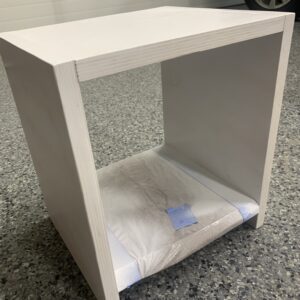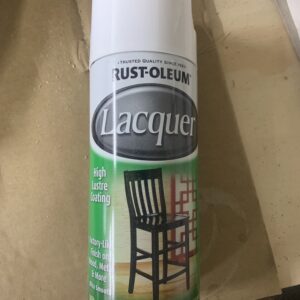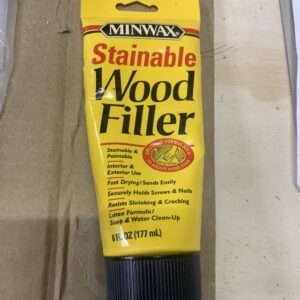Help please! fix SprayCan Lacquer Issues or switch to paint?
Hi! I am making a two-tone bookcase and chose to use spraycan white lacquer because I thought it would give a nice, even, durable finish with the easiest and fastest process. However I’m running into issues and am wondering if I need to do something else for the lacquer or if it was the wrong finish choice. This is the first time I’m putting a finish on anything.
Here’s our project details:
—-Baltic Birch plywood Grade B with lots of big football patches and filled pocket hole plugs we added
—-Rust-oleum White Spraycan Lacquer – high luster Gloss, used with a spraycan holder
Problem: we sanded to 150 and added two layers of lacquer with 1 can but:
—-(see picture 1) You can clearly see the football patches in the face of the wood and the pocket hole plugs even though we had put wood filler in the cracks of the pocket holes. (We added “Minwax stainable wood filler” with our finger. It was hard to work with).
—-The white is uneven where the spray concentrated as it came out. We didn’t hold the can farther away because that put hardly any lacquer on the wood. It’s also hard to get to the inside upper face of the cube. (See pictures)
Questions- Should I:
A) cover all the wood with a layer of watered down wood filler paste before adding the finish to get a smooth surface? We put wood filler on one end grain as a test and it built up the white much faster than the other end grains.
B) Find a Lacquer Primer? The only one I’ve seen is the expensive $14 Amy Howard At Home Furniture Lacquer SprayCan
C) try a different white Lacquer spray can?
D) switch to Paint and brushes? Will it give a nice and durable finish and not stick to books or anything? I’ve seen people talk about General Finishes White Poly and Benjamin Moore’s scuff proof defense + Advance Primer
If we continue with Lacquer spray, we would need to buy a ton more cans because 1 can only gave 2 coats on a very small piece of the project, so I want to make a good choice upfront. This cube is a test-piece so I can switch to anything for the real bookcase.
Thank you for any advice you can give!



















Replies
For context, here’s a look of what the final project will hopefully look like
Looking at your pictures, I notice the grain pattern of the ply. If you fill the patches and sand smooth you will have to texture the result to look like the bulk of the surface. If you fill and sand everything smooth, I would use paint. Think drywall here. Fill, paint, sand down, and repaint until you are happy with the end result.
What you see is the result of using Grade "B" B/B ply. Nothing wrong with that but understand you are not making fine furniture here. Do you really care what it looks like after you put some books and other items on it? Think of those patches as desired character!
I have painted bookshelves and just used paint from Lowe's or HD and have not seen any problems after many years.
I will be starting to make a mid century stereo cabinet for my son shortly using '3/4' B/B ply. It will have a urethane finish, not sure about any stain yet. There are patches but I will make sure to keep these on bottom surfaces or interior sides for this project.
You are doing fine, woodworking is a learning process. The next project will be better. Congrats on your creation!!
Oh does Lacquer always show the grain? We don’t want to see the grain for the white part, so sounds like paint is better then.
What is the purpose of sanding after a paint layer? Do you mean, cover the entire surface with wood filler, then sand, then paint, then sand again? Also thank you for the encouragement!
I do have this wood filler that I could use that I haven’t tried yet…
It's good your doing a test project! I have never used spray lacquer on a project that large, but I feel like it could get out of hand pretty quick.
When I've done solid colored furniture I almost always start with a good primer like BIN. It's shellac based and is a dream to work with. I usually do two coats of BIN, sanding in between and then a couple of coats of paint. Unless you have a HVLP sprayer (which, if you did you wouldn't be messing with rattle cans) a small roller is the best way of handling a piece like this.
ysu65 is totally right about the ply. It's going to be hard to make b-grade look like the expensive stuff. You pay for it with time or money!
BTW... I cleaned up the formatting of your post since it set off my mental "spam" alerts with the bold text.
Thanks for the response! Will BIN primer smooth out the surface so that you can’t see the football patches or pocket holes? Or should I still do something with wood filler before that?
The real answer is that you'll have to try it and see. I doubt it will ever wind up perfect if that's what you're looking for. When you build the final piece, try and be a bit more deliberate about where the patches wind up–like in the back of the selves or where they are likely to be covered by books or something.
RE paint vs spray and filler: Spray is relatively thin and will work fine on a smooth surface if that is your objective. I used it on a small cabinet out of solid poplar that was sanded to 220 so it was pretty smooth. Can paint has more filler and pigment so it will lay on a thicker coat.
Why sand after application? On some things the paint will raise the grain and sanding will remove it. It will also fill low spots so if you sand down the high wood spots, the next paint layer will be smoother. You can continue this to what ever surface comfort level you want.
I just applied five layers of wipe on poly to a hickory coffee table, light 220 sanding after each coat. Wipe on is very thin - kind of. For the final coat I wet sanded with 320, wiped it down very clean, and applied the final coat. After it was dry, go over the surface with a piece of brown bag to knock off any dust nibs. After a day or two, I applied paste wax and buffed. That is one approach to finishing something. Everyone has their own method, most all will work fine.
Keep us informed on your progress, OK?
Ok I will let you know! I never expected such great and fast responses! Im loving the community and encouragement here :)
Since this is my first time, what’s the best way to update you guys on progress? By editing my original post or making a comment on the post?
Any fresh post here will move this thread to the head of the class and has the advantage of having all the original information. So we will know what you are talking about.
Thanks! I’m deciding to do the Bin primer and some type of paint (probably the Ben Moore advance).
I want to test this finish using the same test cube that has the 2 layers of spray lacquer. What should I do to get a reasonable surface that’s ok to prime and paint over as a test?
Light sanding should be enough.
Ben had some good ideas. If I'm going for a painted finish, I always prime first. BIN is great, especially if there are knots.
Most wood filler is a pain. If I'm priming and painting, I'm most likely to use joint compound. I always have a bucket around, it dries fast, and sands easily. I would not use it for filling large voids, but for something like the wee crevice around a football, it's fine.
I think most latex trim paint is too soft for shelves. I usually use Ben Moore Advance, a modified waterborne alkyd paint.
I haven't used small cans for a project like this. It's just too expensive.
Another vote for BIN Primer. but, honestly ANY primer is better than none when going with a solid color.
Just about any paint will show grain, even heavy acrylic wall paints will eventually shrink down and the grain will show... Unless you put it on ridiculously thick.
Put the BIN on, let it dry, give it alight sanding. If the grain still shows, hit it with another coat. BIN is relatively inexpensive, especially compared to spray cans of lacquer. Couple of nice things about BIN, it dries super fast and sands really easily. It also sticks to anything I've ever tried to apply it to, and any finish I've put on top has stuck to it.
Also, clean up... Don't waste money on DNA or any kind of alcohol. Use household ammonia. Cheap and works better than alcohol at cleaning shellac up. Almost instantly dissolves it.
There are many things that compounded to cause the problems you have experienced.
First and foremost bare wood must always be sealed with a primer before painting. If you truly had spray cans of lacquer and aren't just using the term generically then you must be very careful what primer you use as lacquer solvents react badly with many materials. The original Bin primer was shellac based and should withstand lacquer solvents, but many of the newer formulations are not, either way I would test on scrap before painting my project.
As you have found out spray cans of paint are mostly solvents with very little solids in order to enable them to spray with such low air pressure. If your project is similar in size to the picture I would estimate a dozen cans at a minimum to build up enough solids to give an acceptable finish. That is a very expensive paint job and color variations are almost guaranteed.
That filler you showed is worthless for what you need. My suggestion is a filler primer like this one. Just make sure it's compatible with wood and keep in mind you probably will need a whole case to build up enough to do the job and always test your top coat primer combination on scrap before committing. 2 coats sanding between coats with 320-400 grit should do the job in filling most of the fine seams around the patches and grain.
https://www.homedepot.com/p/Rust-Oleum-Automotive-11-oz-Gray-Filler-Primer-Spray-249279/202097276
I would also suggest you consider an enamel style paint which should build quicker than lacquer and not be as sensitive to primers, but always test anyway. The drawback is unlike lacquers which dissolve the previous coat slightly building multiple coats into one solid layer making it possible to sand and buff the finish with fewer potential problems, enamels and acrylics rely on a physical bond where each layer sits on top of the previous layer which means if you are not extremely careful you can sand through and find yourself left with a halo effect which can only be covered up with another layer of paint.
I didn't read all the posts, so here goes. When I use ply I spend time filling the pores first. Smooths out the surface and makes finishing loads easier.
Mikaol
This forum post is now archived. Commenting has been disabled